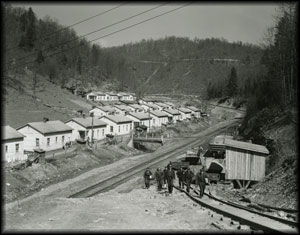 Supply incline track, Jewell Ridge, Virginia.
Supply incline track, Jewell Ridge, Virginia.Photograph. Virginia Chamber of Commerce.
The Library of Virginia.
Bluefield's Eastern Regional Coal Archives, although focused on West Virginia, collects materials relating to the region's rich coal history. The Internet also offers a means of preserving the history of Virginia's coal camps. People who grew up in the camps have designed websites about their towns and established guest books filled with memories of life in the coal towns.
What was life like in a Southwest Virginia coal town? Photographs and company annual reports and financial records are valuable sources of information but leave silent the voices and memories of miners and their families. During the Great Depression, the Virginia Writers' Project, a state-sponsored program of the Federal Writers' Project, an agency of the Work Projects Administration, conducted interviews about occupations and experiences in Virginia's urban and rural areas. The interviews of people who lived in the coal towns of Southwest Virginia attest to the dangers of mining and the hardships endured by the families. Older men and women frequently lamented their lack of education and stressed the need for their children to have better educational opportunities. Mining coal was seasonal; demand fell during the summer months and miners' families gardened and worked at other jobs to make ends meet. The interviews also record the changing relationship among miners, their families, and the coal companies.

